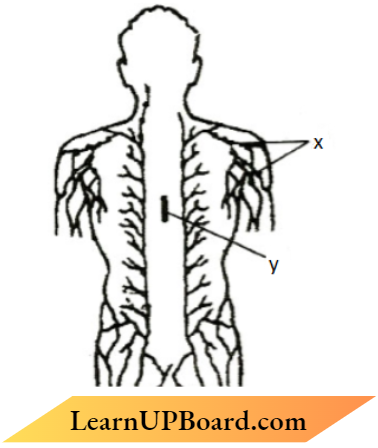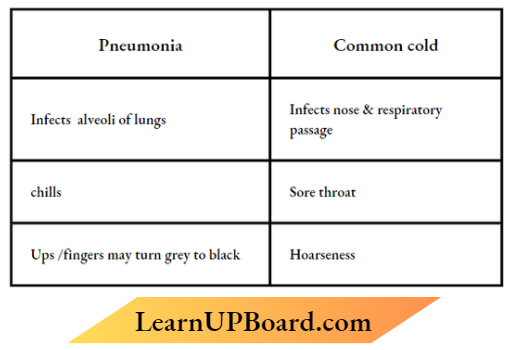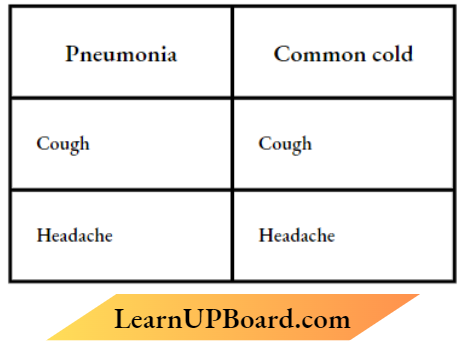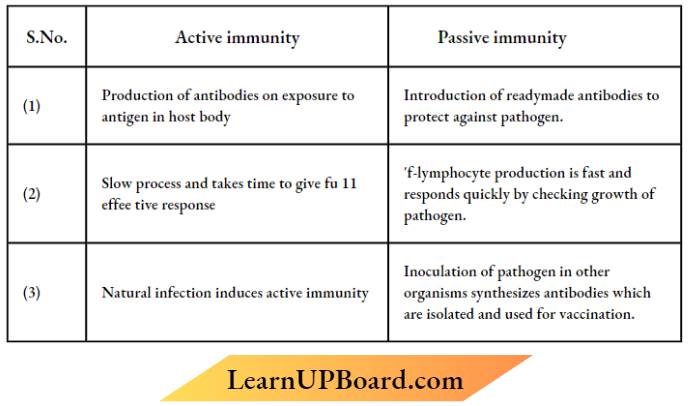Class 12 Biology Chapter 7 Human Health And Disease Very Short Question And Answers
Question 1. write the scientific name of the causative Lent of pneumonia in humans and mention one specific symptom of the disease.
Answer:
Bacteria like Streptococcus pneumoniae and Haemophilus influenzae are responsible for die disease pneumonia. The symptoms of pneumonia include fever, chills, cough and headache.
Question 2. Expand MALT and mention any one location of it in the human body.
Answer:
The mucosa-associated lymphoid tissue (MALT), also called mucosa-associated lymphatic tissue, is a diffuse system of small concentrations of lymphoid tissue found in various submucosal membrane sites of the body, such as the gastrointestinal tract, nasopharynx, thyroid, breast, lung, salivary glands, eye, and skin.
human health and disease
Question 3. For early detection of cancer, 3-D images of tissues are essential. Name the technique and the basis on which it can generate a three-dimensional image of changes in the IMtig tissue.
Answer:
Medical imaging is the technique and process of imaging the interior of a body for clinical analysis and medical intervention, as well as visual repair of the juice the organs
Of tissues (physiology). Medical imaging seeks to reveal internal! structures are hidden by the skin and bones, as well as to diagnose and treat disease.
Read and Learn More Important Questions for Class 12 Biology Chapter Wise
Question 4. The main barrier that prevents the entry of micro-organisms into our body is
- Antibodies
- Macrophages
- Monocytes
- skin
Answer: 4. Skin
Question 5. Colostrum provides passive immunity to human infants as it contains antibody
- IgA
- IgM
- tgE
- igG
Answer: 1. IgA
Question 6. Name any two physiological barriers that provide innate immunity.
Answer:
Acid in Stomach, Saliva in mouth
Question 7. Name the pathogen which causes Typhoid. Name the test that confirms the disease.
Answer:
Salmonella typhl,w idal test
Question 8. How does the body respond when harmony in produced hy is released in its blood?
OR
Write the role of interferons.
Answer:
Chill and high fever occur, in regular intervals every 3 to 4 days.
OR
Virus-infected cells secrete proteins called interferons, which protect non-infected cells (from further viral infection )
Question 9. Name two diseases whose spread can be controlled by the eradication of Aedes mosquitoes.
Answer:
Dengue and Chikunguniya.
Question 10. How do cytokine barriers promote innate immunity in humans?
Answer:
Interferon (proteins) which is secreted by virus-infected cells protect non-infected cells from further viral infection
Question 11. Flow do monocytes act as a cellular barrier in humans to provide innate immunity?
Answer:
Phagocytosis of microbes or destroy microbes.
Question 12. Name the condition in vertebrates where the body attacks self-cells.
Answer:
Autoimmunity.
Class 12 Biology Chapter 7 Human Health And Disease Short Questions And Answers
1. A body developed some allergic reactions when he straight entered his air-conditioned room after a game of football outside his house. Write any two symptoms that could be noticed in such a condition. How does our body combat such conditions?
Answer:
Symptoms of allergic reactions include sneezing, watery eyes, runny nose and difficulty in breathing. The immune system overreacts by producing antibodies called Immunoglobulin E (IgE). These antibodies travel to cells that release chemicals, causing an allergic reaction
evolution pdf
Question 2.
1. Write the Scientific name of the plant from where natural cannabinoids are obtained.
2. Mention the parts of the plant that are used for extracting the drug.
3. How does the drug affect the human body?
OR
The epithelial lining of our intestine is considered a secondary lymphoid organ. Justify the statement.
Answer:
1. Condition saliva
2. Cannabinoids are obtained from the inflorescence of the plant.
3. These drugs affect the cardiovascular system of the body. They affect brain areas that influence pleasure, memory, thinking, concentration, movement and coordination.
OR
There is lymphoid tissue also located within the lining of the major tracts (respiratory, digestive and urogenital tracts) called mucosal-associated lymphoid tissue (MAtT) It constitutes about 50 per cent of the lymphoid tissue in the human body
Question 3. The major cause of death among infants is because of Vcute Respirators Infection ( XRI) of the lower respiratory tract, which further affects the alveoli. Name the associated disease, and a causative bacteria and give any two symptoms of the disease.
Answer:
The associated disease is pneumonia and the most common bacteria causing pneumonia is Streptococcus pneumoniae.
Symptoms:-
Fast or Laboured Breathing – Breathing patterns would be rapid but shallow, directed from the stomach instead of the chest, accompanied by wheezing.
Pale Skin – The skin around the lips and face starts turning blue (a sign of decreased oxygen in the bloodstream).
Pain – Depending on the infected part, he will experience pain in the lungs or the abdomen. Especially when coughing or breathing deeply
Question 4.
1. In our country YVC’O and other Non-Government Organisations (NGOs) are doing a lot to educate people about AIDS. Expand ’NACO’. Enlist any three ways by which transmission of HIV- AIDS infection occurs.
Answer:
National Aids Control Organization
Ways of Transmission
- Mother-to-child transmission is the most common way that children get HIV & This is called perinatal transmission It is less common because of advances in HIV prevention and treatment,
- Used needles, syringes, and other injection equipment may have someone raise blood on them, and blood can carry HIV with someone who has HIV
- The primary way in which HIV’ is transmitted from person to person is when a partner has unprotected vaginal or anal sex with an HIV-positive partner.
2. write the scientific name of the plant and the part from which opioids are extracted. How does it affect our body functions?
Answer:
- Opioids are extracted from the late plant called tie opium poppy, whose scientific name is Papaver souvenir.
- Receptors are present m the central nervous system, cardiomiscible system and gastrointestinal tract.
- Opioids act as a depressant and slow down body functions.
“highlighted ncert biology pdf class 12 “
Question 5. It is often observed that the chances of a person suffering from measles in his or her lifetime are low if he or she has suffered from the disease in their early childhood. Justify the statement.
Answer:
Memory cells develop during measles in early childhood, subsequent encounters with the same pathogen elicit a highly intensified secondary anamnestic response.
Question 6. A student on a field trip suddenly felt breathlessness and started to sneeze very badly. Name this response and explain what it is due to.
Answer:
Allergy Allergens (dust or pollen mites etc.) are due to the release of chemicals like histamine serotonin (from mast cells).
Question 7. Causative organisms of some diseases gain entry into the human body through mosquito bites and make humans suffer from the disease. Name one such:
- protozoan disease along with the scientific name of the causative organism.
- Helminths disease along with the scientific name of the causative organism.
Answer:
- Malaria → Plasmodium vivax Plasmodium malaria Plasmodium falciparum
- Elephantiasis/Filariasis → Wuchereria bancrofti Wuchcicria malayi
Question 8. Write the functions of bone marrow as the primary lymphoid organ and lymph nodes as the secondary lymphoid organs.
Answer:
Bone Marrow-lymphocytes are produced here, develop and mature into antigen-sensitive lymphocytes
Lymph nodes – trap the microorganism or antigens from the tissue fluid, the trapped antigens activate the lymphocytes (present in lymph nodes) to cause an immune response.
OR
What is a vaccine? State the type of immunity that it induces.
Answer:
The vaccine is a weakened/inactivated pathogen, or its antigenic protein, Active immunity
Question 9.
1. Name the source plant of heroin drug. Mow is it obtained from the plant?
Answer:
Papaver somtiifermnlPoppy plant.
Extracted from the latex of the plant or acetylation of morphine (obtained from the latex of the plant)
2. Write the effects of heroin on the human body.
Answer:
Depressant slows down body function
Question 10. Why is the structure of an antibody molecule represented as ILL2? Name any two types of antibodies produced in the human body.
Answer:
L 2 – Two light or small polypeptide chains,
Ha,” two heavy or longer polypeptide chains.
I gA / I gM / I gE / I gG
Question 11. Mention one application for each of the following :
- Passive immunization
- Antihistamine
- Colostrum
- Cytokinin-barrier
Answer:
- Provide preformed antibodies anti-toxins for quick response in ca microbes! tetanus) or snake bite.
- Reduces symptoms of allergy
- Provides passive immunity, antibodies or IgV to newborns.
- Protection of non-infected cells from further viral infection
Question 12.
1. Write the complete name of the diagnostic test for AIDS. Explain the principle it works on.
Answer:
ELISA Enzyme Linked Immune Sorbent Assay. It is based on the principle of antigen-antibody interaction where a pathogen can be detected by the presence of antibodies (proteins, glycoproteins, etc.) on it
“evolution class 12 ncert pdf notes “
2. Name the type of genetic material present in the AIDS-causing pathogen.
Answer:
MIX is a retrovirus, which means it carries single-stranded RNA as its genetic material rather than the double-stranded DNA human cells carry.
Question 13. A patient complains of suffering from constipation, stomach ache, stool with blood clots and excess mucous. The physician diagnosed it as amoebiasis, after a stool test.
- Write the scientific name of the microbe identified in the stool sample.
- How do you think, the patient must have contracted it?
- Write your suggestions to the patient to avoid infection in future.
Answer:
- Entamoeba histolytica
- I houseflies act as mechanical carriers and serve to transmit the parasite from the faeces of infected persons to food and food products, thereby contaminating them. Drinking water and food contaminated by faecal matter are the main sources of infection.
- Perform hand hygiene frequently, especially before handling food or eating, and after using the toilet or handling faecal matter Wash hands with liquid soap and water, and rub for at least 20 seconds.
Question 14. Name any two techniques which can be used to generate a three-dimensional image to detect cancers of the internal organs and explain any one of the techniques.
Answer:
Techniques like radiography (use of X-rays), CT (computed tomography) and MRI (magnetic resonance imaging) are very useful in detecting cancers of the internal organs.
Magnetic resonance imaging (MRI): Magnetic resonance imaging (MRI) is a spectroscopic imaging technique used in medical settings to produce images of the inside of the human body MRI is based on the principles of nuclear magnetic resonance (NMR). which is a spectroscopic technique used to obtain microscopic chemical and physical data about molecules.
Magnetic resonance imaging is accomplished through the absorption and emission of energy of the radio frequency (RF) range of the electromagnetic spectrum
MRI Uses
- Utilizes non-ionizing radiation (unlike X-rays)
- Ability to image in any plane, (unlike CT scans).
- Very low incidents of side effects.
- Ability to diagnose, visualize, and evaluate various illnesses.
Question 15. Given Below Is A Diagrammatic Representation Of the Immune System Of The Human Body:

- Identify ‘ X’and ’Y’ in the given diagram.
- Explain two major functions of the organs that you have identified,
Answer:
1. X – Lymph Nodes
Y – Thymus
2. Lymph Nodes –
- The removal of excess fluids from body tissues.
- Absorption of fatty acids and subsequent transport of fat, and chyle, to the circulatory system
- Production of immune cells (such as lymphocytes, monocytes, and antibody-producing cells called plasma cells).
- There is lymphoid tissue also located within the lining of the major tracts (respiratory, digestive and urogenital tracts) called mucosa-associated lymphoid tissue (MALT) It constitutes about 50 per cent of the lymphoid tissue in the human body.
Thymus – The thymus gland is a lobular structure located between the lungs behind the sternum on the ventral side of the aorta.
- The thymus plays a major role in the development of the immune system.
- This gland secretes the peptide hormones called thymosins.
- Thymosins play a major role in the differentiation of T – T-lymphocytes, which provide cell-mediated immunity.
- Thymosins also promote the production of antibodies to provide humoral immunity.
- Thymus is degenerated in old individuals resulting in a decreased production of thymosins.
- As a result, the immune responses of old persons become weak.
Question 16. Answer the following questions concerning “opioids”, the commonly abused drug :
- Where in our body are the specific opioid receptors present?
- What is heroin chemically known as?
- Write the scientific name of the plant from which opioids are extracted.
Answer:
- Opioids are drugs, which bind to specific opioid receptors present in our central nervous system and gastrointestinal tract.
- Heroin commonly called smack is chemically known as diacetylmorphine.
- Papaver sonmifentni.
Question 17. Name the two primary lymphoid organs in humans. Explain their functions in providing immunity.
Answer:
Bone Marrow: The main lymphoid organ where all blood cells including lymphocytes are produced
Thymus:
- A lobed organ located near the heart arid beneath the breastbone
- Quite large at the time of birth but keeps reducing in size with age and by the time puberty is attained it reduces to a very small size
Question 18.
- Name the causative agents of pneumonia and the common cold.
- How do these differ in their symptoms?
- Mention two symptoms common to both.
Answer:
1. Streptococcus pneumoniae Haemophilus influenza, rhinoviruses
2. Different symptoms

3. Common symptoms

Or
- Write the scientific names of the causative agent and vector of malaria, and write its symptoms.
- Name any two diseases spread by Aedes sp.
Answer:
- Plasmodium vivax P. falciparum P.malariae,vector-female Anopheles mosquito Symptoms chills, high fever
- Dengue, Chikungunya
Question 19. Name is a human disease, its causal organism, symptoms (any three) and sector, spread by intake of water and food contaminated by human faecal- matter.
Answer:
Amoebiasis (Amoebic dysentery). Entamoeba histolytica, constipation abdominal pain cramps or stools with excess mucus or blood clots & causing agent is Housefly.
OR
Ascariasis. A scar is, internal bleeding muscular pain fever anaemia or blockage of intestinal passage and The causing agent is Housefly.
OR
Typhoid, Salmonella n phi, high fever weakness stomach pain or constipation headache or loss of appetite and the causing agent is Housefly.
OR
- Why is there a fear among the guardians that their adolescent wards may get trapped in drug or alcohol abuse?
- Explain ‘addiction” and ‘dependence’ in respect of drug/alcohol abuse in youth.
Answer:
- Adolescents are easily affected by this. (vulnerable to) peer pressure adventure or curiosity excitement or experimentation or media
- Addiction- Psychological attachment to certain effects such as Euphoria or temporary feeling of well-being Dependence- Tendency of the body to show withdrawal syndrome or symptoms if regular doses of drug/alcohol are abruptly discontinued.
Question 20.
1. What is an “allergic reaction”?
Answer:
The exaggerated response of the immune system to certain antigens present in the environment is called allergy The substances to which such an immune response is produced are called allergens.
2. Name any two drugs used to quickly reduce the symptoms of allergy.
Answer:
Anti-histamine, adrenalin and steroids
3. Why do more and more children in metro cities of India suffer from allergies and asthma?
Answer:
More and more children in metro cities of India suffer from allergies and asthma due to sensitivity to the environment. This could be because of the protected environment provided early in life.
Class 12 Biology Chapter 7 Human Health And Disease Long Question And Answer
Question 1. It is commonly observed that parents feel embarrassed to discuss freely with their adolescent children about sexuality and reproduction. The result of Ibis parental inhibition is that the children go astray sometimes.
- Explain the reasons that you feel are behind such embarrassment amongst some parents to freely discuss such issues with their growing children.
- By taking one example of a local plant and animal, how would you help these parents overcome such inhibitions about reproduction and sexuality?
Answer:
- Illiteracy or conservative attitudes or misconceptions social myths etc. are the main reasons.
- If a student gives the clarity of the concept of reproduction and sexuality by taking an example of a plant and an animal to reproductive organs, gamete formation fertilization, sexual behaviour etc.
Question 2.
1. Differentiate between active and passive immunity.
Answer:

2. Comment on the role of vaccination and immunization in keeping the human population healthy.
Answer:
Role of vaccination or immunization:
- Antibodies produced in the body against antigens neutralize pathogenic agents.
- Vaccines also generate memory cells (B and T cells) that recognize quickly subsequent exposure and control the growth of pathogens with massive production of antibodies.
- Preformed antibodies or antitoxin protect our body from deadly microbes like tetanus and against snake venom.
